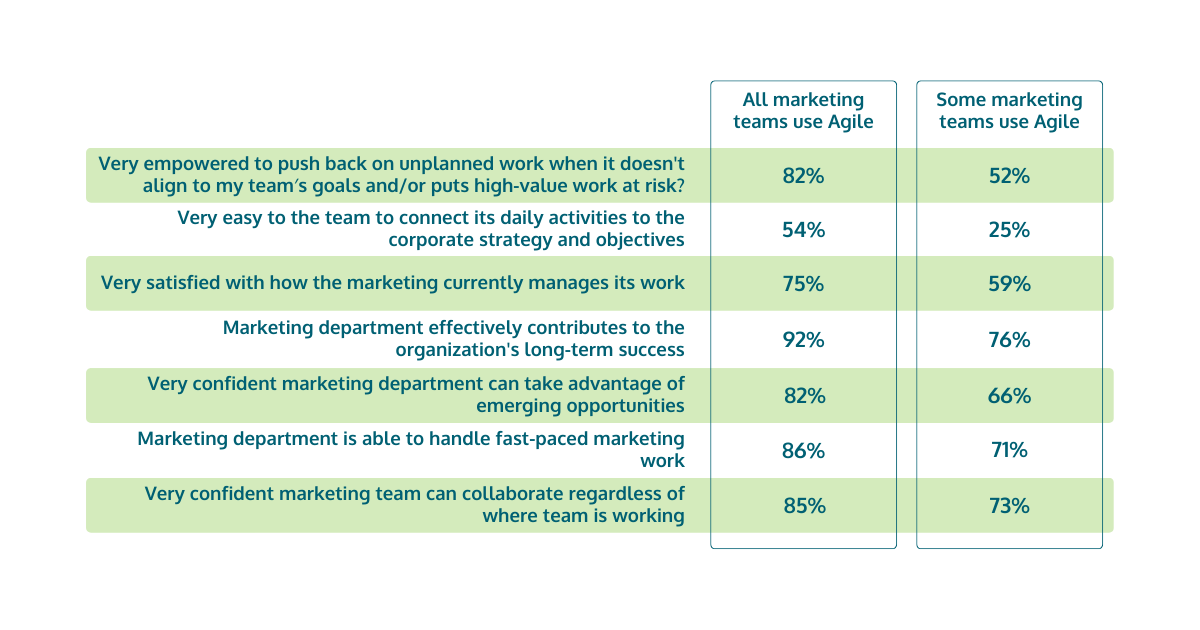-
- marketing agility
- Teams
- Organizations
- Education
- enterprise
- Articles
- Individuals
- Transformation
- Solution
- Leadership
- Getting Started
- business agility
- agile management
- going agile
- Frameworks
- agile mindset
- Agile Marketing Tools
- agile marketing journey
- organizational alignment
- Agile Marketers
- People
- Selection
- (Featured Posts)
- strategy
- agile journey
- Metrics and Data
- Kanban
- Resources
- Why Agile Marketing
- agile project management
- self-managing team
- Meetings
- Scrum
- agile adoption
- scaled agile marketing
- tactics
- scaled agile
- AI
- Agile Meetings
- agile marketing training
- agile takeaways
- Agile Leadership
- agile coach
- enterprise marketing agility
- Scrumban
- state of agile marketing
- team empowerment
- Intermediate
- agile marketing mindset
- agile marketing planning
- agile plan
- Individual
- Team
- Videos
- agile marketing
- kanban board
- Agile Marketing Terms
- agile transformation
- traditional marketing
- FAQ
- agile teams
- Agile Marketing Glossary
- CoE
- Scrumban
- agile
- agile marketer
- agile marketing case study
- agile marketing coaching
- agile marketing leaders
- agile marketing methodologies
- agile marketing metrics
- agile pilot
- agile sales
- agile team
- agile work breakdown
- cycle time
- employee satisfaction
- marketing value stream
- marketing-analytics
- remote teams
- sprints
- throughput
- work breakdown structure
- News
- agile brand
- agile marketing books
- agile marketing pilot
- agile marketing transformation
- agile review process
- agile team charter
- cost of delay
- hybrid framework
- pdca
- remote working
- scrum master
- stable agile teams
- stand ups
- startups
- team charter
- team morale
- user story
- value stream mapping
- visual workflow

Improving the performance of individual teams within an organization is great – that's certainly difficult to argue against. But when teams discover a new, more effective way of working, it can often have unintended consequences when it comes to inter-team collaboration.
Ideally, you want an approach to work management that improves individual team performance while also making collaboration easier.
Fortunately, Agile offers a solution to this problem.
First, though, let's get on the same page about what team collaboration actually refers to and what kind of challenges Agile can solve in that space.
What Is Team Collaboration?
We all know what collaboration means, but when we talk about team collaboration, we’re talking about something a bit more complex. In essence, team collaboration is the ability of teams to effectively communicate, manage work, innovate, and solve problems together.
Of course, that sounds fine in theory, but really understanding team collaboration is easier when you focus on the common problems they encounter.
Common Team Collaboration Problems

The single biggest challenge most teams face collaborating relates to alignment. Teams often have different priorities, expectations of how they should work, and cultures. These differences seem small but can easily lead to serious problems.
For example, let's say one team prioritizes based on deadlines. This means that if work has no deadline, it may as well not exist because it will never be a priority. So when another team asks if they can do something without specifying the deadline, the work doesn’t get done, and problems soon arise.
Culture plays a significant role as well. For example, one team might strive to avoid last-minute work because it hurts their productivity. As a result, when they get last-minute requests from other teams, it creates frustration and resentment.
That’s not to mention the classic issue of different teams simply using different work management tools. For example, one may be in Asana, while another uses Monday; one team chats via Slack, while another uses Teams. This inhibits collaboration because it creates extra friction between teams, as people will need to set up new tools just to communicate.
Then there’s the reality that teams will inevitably manage to find yet more causes of friction between themselves. So how can you address the existing problems while minimizing the potential for new ones?
Agile Teams Prefer Working With Other Agile Teams
With the recently published Annual State of Agile Marketing Report, we’ve seen a continuation of a long-running trend: Agile teams vastly prefer working with other Agile teams, as it enables them to collaborate far more effectively.
Breaking down data from this year’s report shows why:

This data may be marketing-focused, but the conclusions echo what we’ve heard from teams across the spectrum, from HR to sales. Across the board, teams feel that working with fellow Agile teams makes it easier to do everything from pushing back at unplanned work to contributing to the organization’s overall success.
But what’s behind all of these numbers? What’s the secret to Agile’s ability to improve how teams feel and perform?
How Business Agility Affects Team Collaboration
When an organization has undertaken a full Agile transformation and all its teams become Agile, collaboration becomes easier in four key ways.
Mindset
Anyone who has tried to do business across cultures knows that mindset can have an enormous impact on how people and organizations interact. For example, when working across different mindsets, teams have to invest far more time in setting expectations, ensuring they communicate clearly, and generally double-checking that everyone is on the same page.
Contrast this with what it’s like to work with teams or individuals with the same mindset. Far less communication is necessary for work to proceed smoothly. An Agile mindset does just that, ensuring teams share a common understanding of goals, processes, and culture.
The data cited in the table above bears this out, showing how, for example, Agile teams find it easy to say “no” to fellow Agile teams because they share a common mindset around prioritization and value-delivery.
Visibility
One reason why teams using different tools to manage their work has such an impact is the harm it does to visibility. When teams can quickly and efficiently see what other teams are working on, have access to the necessary information to complete tasks, and generally feel more empowered, they will collaborate more effectively.
For example, it’s common for a team to request work from designers. However, the designers may not have access to the necessary context or other information to do that work. This creates blockages that waste time and create friction.
Agile visibility tools like Kanban boards ensure that all the context and necessary information is readily available across teams. For example, let's say a writer is wondering whether to ask for help from a designer; a glance at the design team’s board will tell them what their colleague's workload is like without even asking. The other side of the coin is when colleagues don’t have access to the necessary context or other information to do that work, it can create blockages that waste time and create friction.
Structure
Whether your work is broken into sprints or not, Agile principles based around stakeholder value help make it easier to decide what work should be done (and when) – instead of relying on different teams to argue for what suits them best. Common understandings of how teams should approach challenges like prioritization also make it easier to structure work across teams and functions.
So when one team says, “we’re slammed this sprint, but we can add that to the backlog for our next sprint,” a fellow Agile team will understand exactly what that means (and why!). Agile also provides teams with a common structure for work requests, making it easy to begin collaborating under a shared understanding of how that should operate.
Alignment
The benefits we’ve mentioned above help highlight why it’s easier for Agile teams to align horizontally with each other. But it’s also important to show why Agile makes it easier for teams to align vertically. Those same visualization boards offer a way for senior leaders to share goals, which teams can then align their work towards.
By making it easier for teams across the organization to be aware of and tie their work to these goals, teams can more easily align. For example, a team can push back on a work request by arguing that it doesn’t contribute towards any of the broader goals.
Unlock Better Team Collaboration with Business Agility
As one might expect, with all the benefits full business agility brings, getting there requires some effort. Usually, organizations will begin by equipping leaders with Agile training, trying an Agile pilot program, and generally equipping key teams and figures with coaching and training before attempting a total Agile transformation.
Fortunately, it’s never been easier to access the kind of information and coaching needed to achieve all the team collaboration benefits Agile brings. We offer both self-paced or instructor-led courses in Business Agility Fundamentals to equip you and your teams with the knowledge they need to work smarter and collaborate better.
Topics discussed
Improve your Marketing Ops every week
Subscribe to our blog to get insights sent directly to your inbox.


